|
ERIC
DOLPHY
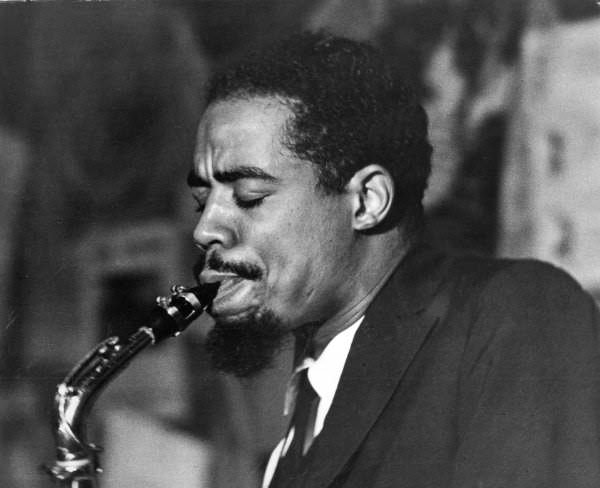 Eric Dolphy is a multiplayer player who mainly plays
Alto saxophone, plays flute and bus clarinet as well. He was born in Los
Angeles, California in 1928 and died in 1964. Eric Dolphy is a multiplayer player who mainly plays
Alto saxophone, plays flute and bus clarinet as well. He was born in Los
Angeles, California in 1928 and died in 1964.
Please listen to any performance of the album introduced
below. You surely will be surprised if you listen to his performance for
the first time. Even if other players I introduce on the homepage - Art
Pepper, Stan Getz, Art Farmer - have different styles such as hard bop and
cool jazz, they have a base of common music called jazz. However, in the
performance of Dolphy, the base they have in common is broken. You will
have the question of "Is this music?" That is not strange. The phrase he
plays is different from the general image of melody. You will not think of
the phrase he plays as a form of melody, and will think that only a few
sounds are continuing. Besides, he creates a sound like a banging sound
from the instrument as if it is becoming faint. If you barely find music,
it's only beating monotonically.
One of the reasons
why he plays such a broken performance is the influence of the era when he
played an active part. In the early 1960s, the popularity of jazz as mass
music waned. Hard bop, which was the mainstream of jazz at the time, lost
momentum, a new attempt to create a new mainstream faction and free jazz
was born. He bridged from hard bap to free jazz in jazz. When you listen
to the word free jazz, it will be thinking that it is music that is
nothing but noisy music or loud noise. You will have such an impression by
listening to his performance.
"What is good about
this?"
You will want to ask
simple questions.
His music limits the
listeners. He did not play the type of being accepted by
everyone.
But even if you have
doubts about his performance, you will not be able to deny the
overwhelming power of his performance. You may say that his performance is
noisy, but you can not deny that the noisy of his performance is
extraordinary. That is a big feature of his performance. In fact, he makes
the bellibari and the instrument itself resonate enough to make him think
that he will break the alto saxophone. The sound that he is echoing with
instruments is unbelievably rigid and sounds like jamming the saxophone's
core as it is, filled with junk and inside. If you listen to the sound,
you will feel that there is no clearance in the sound, there is no part of
play, you will feel urgency when listening. You will not feel fine dust,
such as comfort that you will want to leave yourself touched by the sound
of his. His sound is seriously serious, and it is loud and it is a
tremendous sound pressure. You only listen to one sound, you know that
sound is his sound. His sound penetrates our heart
like a thick spear.
As a characteristic
of his performance, what I will point out next is a unique phrase. I want
to ask you. If you heard that he plays a beautiful melody with the loud
noise he explained so far, can you feel comfortable with his performance?
Perhaps you do not have a disappointing impression. Rather, you would like
him to overwhelm with its overwhelmingly powerful sound. His unique phrase
is what you ask for like that. With that sound, he rides on the beat and
undulates, as if it rolls out a phrase full of drive feeling like getting
involved. He plays a distinctive phrase with a free key tone that makes
the sound leap, making me think of a unique roar. If you extract only the
phrase that he plays, you might think that it is haphazard.
For example, he
always plays one pattern when he comes in. It is a phrase with a rough
decorated "pa, para, paara, paara". He plays this phrase with 4 beats,
with a heavy tone, as if something bounced off. The moment I heard this
phrase, I feel like the beat is unleashed at once. I feel that the feeling
of the beat the whole band members are making explodes at once. And I feel
it is really comfortable. I am also listening, it will be released. That's
why he never played bullshit. He thinks better than any other Alto player,
chooses the sound, controls it and is blowing. If you've never played sax,
you can understand it, but skillful techniques are necessary to play
phrases that repeat an octave extremely like him. And like him, continuing
to breathe his distinctive phrase awesome in timbre is beyond the limits
of ordinary people.
I cannot get used to
it, no matter how many times he listens to the phrase he plays. When I
listen to his phrase, my heart is irritated and irritation, I feel uneasy
and discomfort. Both of his sounds and his phrases, I feel stupid
seriousness. When I start listening to his performance, I want to laugh at
the beginning. And as I listen to his performance, I can not help
laughing. I am facing seriously in the end.
While you are
listening to his performance, I find something in his bogus phrase and
feel it. Compared to him, the performance of big players at the same free
jazz dawn is easy to understand. For example, Ornette Coleman is blowing
as he wants to blow at that time. People who listen to Ornette's
performances do not think "Oh, I do not understand anything anymore", "I
do not know what it is but I do not know what he wants to blow like this
now anyway." But listening to the music of Dolphy I think that you are
playing based on some theory. But you do not have any idea what that
theory is, so I think it is difficult. So, the performance of Dolphy says,
"I do not know what he is saying, but there surely exists a strong theory,
and I think that the meaning of music will definitely be transmitted to
myself."
|
At The Five Spot
vol.1@@@@@PXUPNVPUú^¹
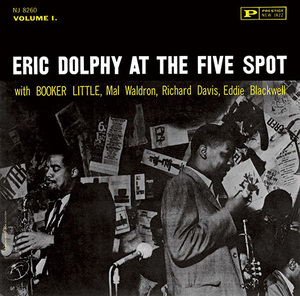 Fire
Waltz Fire
Waltz
Bee
Vamp
The
Prophet
Eric
Dolphyias & bclj
Booker
Littleitpj
Mal
Waldronipj
Richard
Davisibj
Ed
Blackwellidsj
What an aggressive performance of the first song "Fire
Waltz"! This performance contrasts with the flexibility and humorous
aspects of Ornette Coleman. Eric Dollfie, Booker Little and other
members' performances are full of serious enthusiasm I feel. An
intro by a piano like an out of tune ragtime piano is the beginning
of a performance. Soon he will start playing bluntly the saxophone.
The theme he plays seems to be a rhythm pattern with almost no
melodic up and down movement, "Dara Lara, La Rala · Pappaler". After
this, he will perform an ensemble with the trumpet for a short time.
And he tried a leap of sound which is completely unrelated to the
theme, and then started ad-lib performance like free jazz.
Here, derail
slightly. Because the word "free" I mentioned now requires some
explanation. We intend to read and understand the word "free" in
jazz commentary and liner notes of the album. But we do not know
what is free in their actual performance. Here, almost all phrases
that they are performing improvisely are fragments that are not
terminated. Compared to this, the impromptu phrases of the
performers like Charlie Parker before them, in principle, the
listener feels that the melody is over. Let me explain it clearly.
For example, when we are talking, we judge in an undisputed manner
that the other party has finished talking. In conversation, we
follow it according to an implicit rule. If we do not follow that
rule, we will only speak one-sidedly to each other, they will not
listen to the other's story. It is called nodal form in music
theory. We recognize the movement of the sound on the system of
tonality and judge that the melody is over when we return to the
fundamental tone. That is an implicit rule. In accordance with the
rule, we grab the melody and judge it to be beautiful. Even Charlie
Parker sometimes violates the rules, but he is aiming at temporary
effects such as surprise the listener and prompt the imagination of
the listener. However, Eric Dolphy and Booker Little here throw out,
ignoring the rules and not taking the end form that ends the phrase.
So we do not know whether the phrases they play are melodies. It is
the same as we are in a state of dangling that we do not understand
when we talk about whether the story is ended. And yet, while Eric
Dolphy was not able to judge the phrase as a melodious, Eric Dolphy
set it aside and started already the next phrase. This is his
wonderful place. We feel that we cannot keep up with his performance
there. That is the speed of his performance.
Besides, he
keeps the regular rhythm and shakes the rhythm sharply. If other
players do this, their performance will collapse musically. However,
their performances are likely to collapse musically and they will
not collapse. Their performance is on the demarcation boundary line.
So, the tension is abnormally high. It is the achievement of the
rhythm section that did not let their performances collapse. The
drum made a snare fine noise and made a mechanical beat. The piano
mechanically repeated a minor chord block heavily using the
midrange. They carved the beat regularly like a machine. It was not
a flexible rhythm in the bebop. Eric Dolphy and Booker Little are
sometimes playing themselves independently of their beat. That's
free of their performance. Moreover, their performance did not
collapse.
I think the
real value of their performance is in the second half. That's
amazing! Filled by Dolphy and Little, the rhythm section
mechanically beating beats will change free rhythm like free jazz.
For example, Mal Waldron is a pianist who plays the piano like a
percussion. Here, he especially carved the beat mechanically, but in
the second half he will change to a melodic solo performance while
breaking the rhythm. And he finally plays solo like Free Jazz like
Dolphy and Little. I think it is a miracle that their late
performance did not collapse. Furthermore, I still cannot believe
that their performance was over.
The second song
"Bee Vamp" is a song written by Booker Little. The composition of
this song is ABACABA, and the measure division is 8-4-8-8-8-4-8. In
the middle of solo correspondence such as delivery of trumpet and
piano theme and accompaniment, snare of drums is fragmentarily
inserted. We can hear the multilayered rhythm composition like
Polyrism. We can find elaborate compositions like this modern
classical music for this performance.
And in the
third song "The Prophet", Alto Sax of Dolphy repeats a unique phrase
like an alien on a composite beat that produces different rhythms
between the base and drum unit and the piano. On the other hand,
trumpet of@Little is
outright. Repeat the solo performance for two people to
compete. |
|
ERIC DOLPHY IN EUROPE
vol.1@@@@@@PXUPNXWú^¹
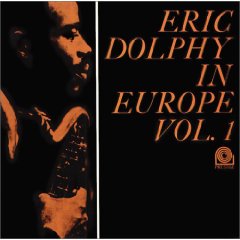 Hi
Fly Hi
Fly
Glad To
Be Unhappy
God
Bless The Child
Oleo
Eric
Dolphy (fl,bcl)
Bent
Axen (p)
Chuck
Israels (b)
Erik
Moseholm (b)
Jorn
Elniff (ds)
This album is a live recording board where Eric Dolphy
went to Europe and made a live performance together with the local
musicians by improvising members. With this album, we can hear
Dolphy playing flute and bus clarinet. If you want to listen to Alto
sax played by him, listen to vol.2. In the introduction of "At The
Five Spot vol. 1" I wrote that the rhythm section carved a regular
beat. The members at this time were people whose sensation of a soft
rhythm of black jazz is stuck in the body. They played with a
mechanical beat so as to disobey the rhythmic feeling of the body.
It was impossible to imagine there, and I think that Dolphy was not
satisfied. However, European white musicians are cultivated in an
ensemble tradition where individuals like orchestras do not comply
unless they comply with the rules. They have different musical roots
from black performers. In this series of European record boards, the
rhythm section has different members but its regular beat is
strictly engraved as it normally is. Most of them keep 4-beat of
constant speed, but not only that but they are making various
changes. Dolphy is away from the beat and is playing freely. The
musicians in the rhythm section will play the rhythm sometimes away
from the beat if someone of them maintains a beat. The resonance
like polylism created by them can be heard more remarkably than "At
The Five Spot vol. 1". Furthermore, we can also touch the static
part of Dolphy with this album.
In the first
song "Hi Fly", Dolphy's flute and Chuck Israel's bass play in duet.
Dolphy starts playing the flute without accompaniment. He plays an
incredible melody fake. His flute performance seems to fly lightly
with a thick core tone. When the accompaniment of the base is added
from the middle, the beat gives driving force to the performance. In
his flute, in the ad lib part, the phrase unique to Eric Dolphy
plays afterwards. The base keeps the rhythm strictly so that it
stiffens the flute's scaffold. For this bass performance, I feel a
spiritual spirit. On the other hand, the performance of the flute is
indifferent but it is pleasant. The ensemble of two people keeps
moderate tension, while a quiet euphoria rises up.
In the next
"Glad To Be Unhappy", Dolphy relaxes and plays a flute with
accompaniment of a piano trio. He plays the theme thoroughly with a
flute that is impressive with a gentle melody. However, we receive
the theme he plays as a creepier tension, rather than gentle. This
tension is analogous to the breath of a lion who is breathtaking to
pretend to prey with his eyes in paraphrase. In the ad lib part, the
performance changes and it becomes development which is raging.
From the third
track "God Bless The Child", he switched the flute to the bus
clarinet and shows solo
with no accompaniment. He will not play the original melody
of this song, perhaps, on purpose. He repeatedly plays the scale
like an arpeggio using the bass clarinet's low range, as if to
search for something loud. When we started to get bored with the
performance of the bass scales, he played the original melody in the
high range with full. This effect was enormous. The impression of
the tone color of the high range of the bus clarinet that he plays
seems to be crowded with a little distorted feeling of texture that
is different from the fat tone pressure rich tone coloring in the
lower range until then It is such a painful tone. We feel there
contrast, static, abstract and concrete. And in the last "Oleo"
exciting
performance. |
|
ERIC DOLPHY IN EUROPE
vol.2@@@@@@@@@PXUPNXUúAWú^¹
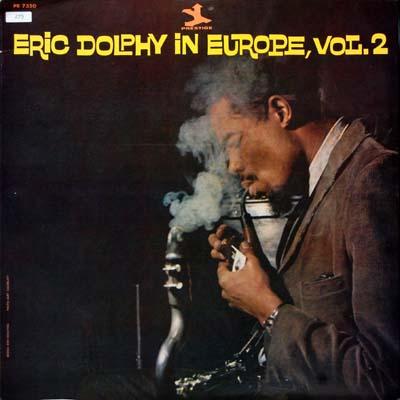 Don't Blame Me Don't Blame Me
Don't
Blame Me (take 2)
The Way You Look
Tonight @
Miss Ann@(Les)@
Laura@
Eric
Dolphy (as,fl)
Bent
Axen (p)
Erik
Moseholm (b)
Jorn
Elniff (ds)
In the first song "Do not Blame Me", the rhythm section
regularly plays a regular 4-beat. He shakes the rhythm with a
feeling of distance not too far from their beat. Based on that, he
plays a mysterious theme by flute, twisting and entangling phrasing.
He uses improvisation within the framework of the hard bop style by
utilizing the element of free jazz like a hidden taste of spice.
Therefore, those who cannot listen to free jazz will be amenable to
this performance.
In the second
song "The Way You Look Tonight" he switches flutes to Alto
saxophone. From this song, his alto sax with a technique of
manipulating freedom of gravity wanders through the music space in a
row. He plays high speed ad libs like Charlie Parker at full speed
from the beginning of the song. His fast improvisation emanates
tension and energy without instantaneous loosening. However, I feel
stylistic in this performance. When he was surrounded by European
crowds and members that were different from the United States, he
was strongly aware of the music climate and the physicality that he
thought of as a matter of course in the performance in the United
States. He realized that the music climate and physicality differed
with skin sensation. He was not able to use jokes and parodies that
were unnecessarily explained in front of the American audience in
the same way in front of a European audience. Please compare his
performance with his performance at "At The Five Spot vol.1". He
also plays parodies and high-speed ad libs in the performance at "At
The Five Spot vol. 1". In comparison, his performance here is calm
without the heat like the performance of "At The Five Spot vol. 1".
He feels the musical discommunication with the rhythm section and is
playing precisely to trace formally on the music.
In addition to
the third song "Miss Ann (Les)", he plays a speedy feeling to fly at
the accelerator full speed from the beginning of the song. Although
he was never playing free jazz, he was taking a stance closer to
that, in fact, he played that kind of style. I explained the word
"free" in the introduction of "At The Five Spot vol. 1". In Europe
with a culture different from the United States, though not related
to jazz, missing 20 th century classical music already existed. In
Europe, he should have noticed that the music he is playing is not
necessarily "free". Rather, he noticed that Bebop, who tried to get
out of there when he was in the United States, was freshly accepted
by European people. So, I guess he tried to grasp his own
performances objectively. That's why his performance is more
conspicuous than the heat he had in 'At The Five Spot vol.1'. He
meets a heterogeneous music culture called Europe, and he confirms
each of his own phrases one by one.
In the fourth
song "Laura", the phrase he plays is not simply diverging and
radiating like drawing a complex helical curve, but music that will
feed back to himself and returning music It is a sign of appearance.
That is the opportunity to become calm music in his early later
years, this is around the performance. He closed the boundary with
other jazz by making the world self-contained with the first album
"OUT TO LUNCH". After that, I imagined that he grabbed the
opportunity to open the door which was closed by "OUT TO LUNCH"
here. |
|
OUT TO
LUNCH@@@PXUSNQQTú^¹
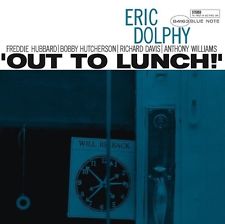 Hat And
Beard Hat And
Beard
Something Sweet,Something
Tender
Gazzelloni
Out To
Lunch
Straight Up And
Down
Eric Dolphyias,bcl,flj
Freddie Hubbarditpj
Bobby Hutchersonivibj
Richard Davisibj
Tony Williamsidsj
This album is a studio recording, we can touch the
possibility of Eric Dolphy which is totally different from live
recording. In this album he is making a performance that is exactly
opposite to the centrifugal direction of spreading of music, which
is quite different from live recording. He is playing in a direction
that seems to fill the space in a closed world rather than
spreading, which is a self-contained music space that cannot be
realized at the live stage. When you listen to this album, you will
receive the impression that you are wrapped in space like a fetus in
the womb, blocked from the outside world, and integrated. The sound
that distinguishes the drum that cuts the space sharply and the vibe
that resonates cool is precisely calculated and calmly constructed
by him. And in this sound, he plays his distinctive twisted phrases
at Alto Saxophone and Bass Clarinet. You must have the impression
that for this album, the world is "an exactly crazy clock." It's
just like an album jacket.
The first song
"Hat And Beard" is a song that was inspired by a split variation of
the composite beat which becomes 9 beats in total. Trumpet, bass
clarinet and vibraphone give a rhythmic accent with a big band
backing. Among them, the bass and drums begin playing the
introduction section at 9/3 time signature (3, 3, 3). And, they play
the presentation part of the theme and the ad lib part with the
metaphor of 9/4 beat (5 · 4). Even if I say this, you may not know
what it is. Try to beat the first place by hand. Then, you will have
extra clapping on its way. Or, since each instrument is playing with
a different rhythm, you do not know what instruments you should clap
to. Basically, Dolphy is playing solo in accordance with the rhythm
of the bass and drum. However, you will feel that he flies freely
over their rhythm with a small fake. Moreover, he plays a phrase
that does not become a fragmentary phrase like his unique twist.
Moreover, he plays with a mysterious tone that I cannot imagine from
Alto sax. You will have the impression that the space distorted from
the beginning will move further in the direction of distortion with
this solo and that the vibraphone stabs the stop.
In the second
song "Something Sweet, Something Tender", with a bass-based
accompaniment, he plays a melody with chromatic elements. It sounds
like a hard avant-garde of 20th century classical music. For
example, an irregular and diverse development of a composition
method in which 5/4 beat or 6/4 beat is short inserted in the middle
of a song, or theme solo
after a theme
with a short buscra break in between again. However, this song is
super slowly ballad. You will wonder. This song is free-form
composition and expansion, but is the performance free? The
performances of the members are played on the score as classical
music. People who listen to the impromptu performance of Bebop
listen, it is a breathtaking performance.
The number
after this is on parade of metaphor. However, the performance of
that metaphor is not so much related to the body that the body moves
unexpectedly like the groove or swing feeling born from the flexible
rhythm of the conventional jazz, the mechanical time . It saturates
with romantic music that the composers of 20th century classical
music around 1950 appeal to the human emotions, making music like
intellectual composition like mathematical calculations It is
similar to it. Especially, at the expense of jazz 's physicality and
improvisation, this work pursued the freedom of making music and
composing, in a sense it is possible to play music that is ringing
in the imagination of Dolphy I tried to reproduce as much as
possible, I
think.@ |
|
LAST
DATE@@@@@PXUSNUQú^¹
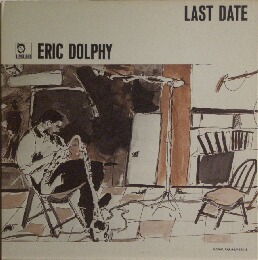 Epistrophy Epistrophy
South
Street Exit
The
Madrig Speaks,The Panther Walks
Hypochristmutreefuzz
You
Don't Know What Love Is
Miss
Ann
Eric
Dolphyias,bcl,flj
Misja
Mengelberg (p)
Jacques
Schols (b)
Han
Bennink (ds)
After listening to Dolphy's first recording "OUT TO
LUNCH", let's continue listening to this album. You feel as if you
are wrapped in a kind of gentleness, not in this album, as if you
were feeling as if you were breathtaking enough in "OUT TO LUNCH".
He recorded this album a few days before his death. Certainly, from
that episode, we will fabricate a story of a desperation that made
this album ahead of his death. I do not think such things. However,
for example, in the past he was sounding and resonating instruments
so strongly that the instruments are likely to be broken by strong
sound pressure, but here it is time to exhale, like the
reverberation of the instrument's reverberation Ringing instruments
to take advantage of skillfully. Also, at "OUT TO LUNCH" he was
playing with a complex rhythm like on parade of metaphor, but here
he is keeping constant 4 beats all the time. Therefore, you can get
a sense of security. However, he is not only keeping 4 beats, but
also makes various changes in it. For example, his play itself is
free from the beat, and if someone keeps the beat and the musician
who is backing, others will be away from there as well. Through the
combination of them, they are producing poly rhythmic sounds. This
fascination is inherently his original charm.
In the first
song "Epistrophy", in the gentleness mentioned above, he plays a
phrase which flies unique. This makes us distinctive features of
him. Moreover, it is less likely to cause incongruity and
strangeness. A surprise of the first roar and an ad lib like
grotesque, as if it is a ringer of an alien. Unlike it has ever
been, it has relaxed because of form power. Besides, since the drums
and the base firmly keep 4 beats and do not fuck dolphy too much, it
keeps backing, so Dolphy is comfortably playing saxophone. It makes
you understand it as nature. And backing of the piano. Chirped and
choked, occasionally repeating an effective riff, backing and rare
harmony of free jazz and modern music-specific coordination.
Discordant clusters reminiscent of Thelonious Monk. It is also
different from the "sticky weight" of the piano played by the black
people, "heavy heaviness". Although it is dull, it is a mysterious
piano that can feel the edge somewhere. This piano is effectively
coloring his bus clarinet.
In the fifth
song "You Do not Know What Love Is", he plays a chromatic melody
with a flute with a duo with a bow playing base. The melody seems to
be a chromatic melody by Debussy's "Prélude à" L'après-midi d'un
faune "by the flute solo at the beginning. And he is improvising for
12 minutes based on that phrase. There, he plays a beautiful, moist
and beautiful moist, playing a game with a phrase, almost without
mixing a free-key tone that makes me remember the roar of my own
patent. There are not a few people who say this performance as a
white eyebrow of this album.
The final "Miss
Ann" is not a feeling of free jazz, but an unexpected phrase unique
to he is contained in the hard bop. Finally, there is a famous his
monologue, but there are lots of people arguing that it is likely to
be about that, so I think that you can create a story and enjoy it.
However, when playing is finished and a short fade out of clapping
is done, it becomes a truncated dragonfly, so I think that it is
finished quietly and has the effect of leaving a finish by sounding
a calm voice. I do not care little whether he is
talking. | |





